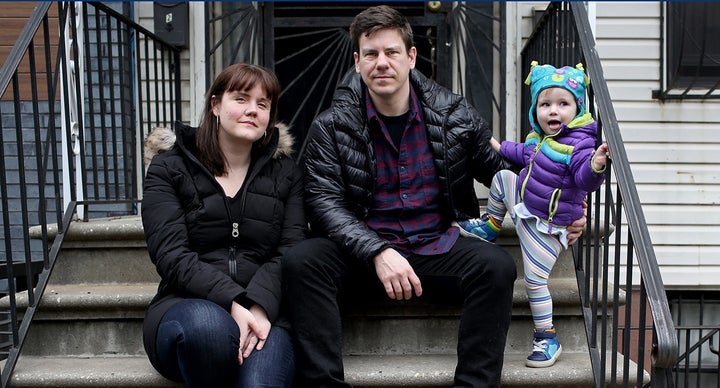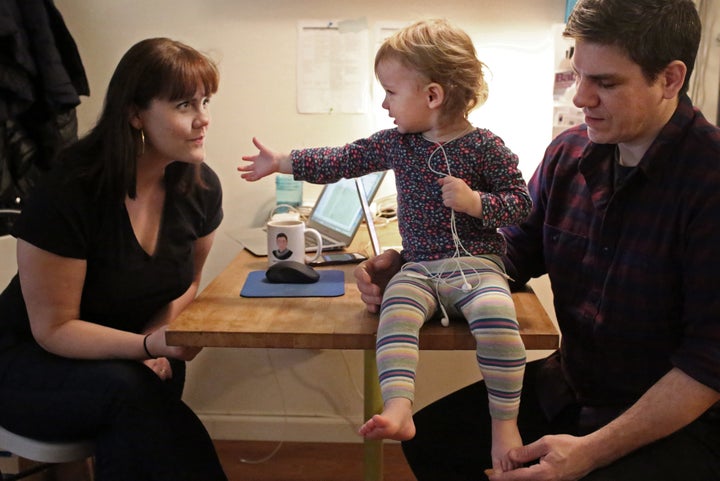
It had been two and a half years since Erika Christensen had flown from New York to Colorado for a late-term abortion, but the news over the last few weeks brought it all back to her: the articles and protesters who called changes in New York and Virginia law “infanticide,” and the State of the Union speech that made the same claim. This convergence of voices saying that the agonizing choice she had made with her husband, Garin Marschall, was equivalent to murder. So they started writing.
He wrote an open letter, titled “We are later abortion patients.” He wrote: “We are not monsters. We are your family, your neighbors, someone you love.”
She, in turn, wrote on the websites of several support groups — secret, members-only sites with names like “Ending a Wanted Pregnancy.”
“Are you a later abortion patient (21 wks+) from anywhere in the country who is interested in a quick advocacy opportunity for later abortion access?” her messages said. “Please reach out through any of our channels or PM for more info. #theirliesdependonoursilence.”
Before long they had nearly 130 signatures on his letter, more than half from people going public with their stories for the first time.
In the course of the struggle over abortion rights in the U.S., there have been periodic episodes of attention to late-term terminations, defined as ending a pregnancy after about the 20th week. Each spike brings a wave of patients who step forward to share details of their own late abortion, hoping to give a human face to what they describe as personal anguish but know that some others see as callous disregard for life. In the past few weeks there has been a larger, more public and seemingly angrier outpouring of such tales than in recent memory, one that seems in keeping with these angrier, more anguished times.

“People told us ‘I’m sick of hiding, I’m sick of pretending that this didn’t happen in my life,’” says Christensen, who herself had to travel from her home in Brooklyn to a clinic in Colorado for an abortion in her 32nd week of pregnancy. The son she was carrying had a number of malformations which doctors told the couple were “incompatible with life.” If he were born alive, he would suffocate either immediately or soon after birth. By the time this could be diagnosed with certainty on a sonogram, she was well past the 24-week cutoff for termination in New York state.
Those who signed her letter have similar tales and “are angry at being accused of killing their babies on a whim,” Christensen said. “They hope their stories can add context to this hideous rhetoric that we’re hearing.”
Only 1 percent of abortions in the U.S. — around 15,000 a year — occur in the 21st week or beyond, according to the Guttmacher Institute. The organization, which both sides of the debate usually credit as an impartial source, says there is no hard data on the reasons for those abortions, but offers some explanations. Some women do not know they are pregnant until well into their pregnancy, some try to have the procedure sooner but are stymied by legal or practical obstacles such as waiting periods and the need to travel long distances to clinics, and some only learn of fetal anomalies or risks to their own health until the second or third trimester.
This small percentage of pregnancies has been in the news a great deal, as some states seek to secure abortion rights in anticipation that the Supreme Court will overturn federal protections. New York’s Reproductive Health Act, for which Christensen and Marschall have been lobbying for for several years, would allow abortions after 24 weeks if the fetus is not viable or if there is a risk to the mother’s health, eliminating the need to travel to other states. And Virginia’s HB 2491 would have expanded the circumstances under which third trimester abortions would be permissible, including nonviability and severe fetal anomaly.
President Trump referred to both during his State of the Union address, saying, among other things, that “Lawmakers in New York cheered with delight upon the passage of legislation that would allow a baby to be ripped from the mother’s womb moments before birth.”

Anti-abortion groups are pleased with this recent focus on later abortions, says Mallory Quigley, vice president of communications for the Susan B. Anthony List, because they regard it as a wedge issue that can bring voters around to their side. Polls find that 60 percent of Americans say abortion should be legal in the first three months, 28 percent in the second three months and 13 percent in the final three months.
“The pro-life movement is only too glad to talk about [later-term abortion],” Quigley said. “When it’s in the news like this, there’s a visceral reaction and people are repulsed.”
To be clear, the goal of the anti-abortion movement is to end all abortions; activists hope to capitalize on the public’s “visceral reaction” to aborting a fetus late in pregnancy to make it illegal at any point.
But patients who have had abortions after the first trimester say public opinion reflects the fact that the issue is oversimplified at best and lied about at worst — by voices that now include the president of the United States.
“To have the nation recoil in disgust and horror at what was our lives has a lot of us feeling tense and exhausted,” said Margot Finn, a lecturer at the University of Michigan and an administrator of the private “Ending a Wanted Pregnancy” Facebook page, which she says has seen a surge in membership requests in recent weeks. “And then our president called us murderers in his State of the Union address and promised to make what many of us did illegal. Half of his audience —our elected representatives — stood and applauded that line.
“People who condemn this law often have no apparent familiarity with the circumstances that cause people to seek abortions after 24 weeks,” she wrote in her own coming-out essay in Slate soon after the State of the Union with the angry title “I Had a Late-Term Abortion. President Trump and Pro-Lifers Have No Right to Call Me a Murderer.”
“They assume the babies aborted after this point would otherwise be healthy and the only reason to end any pregnancy is because you were careless with sex,” she wrote. “They seem to assume ending your pregnancy after 24 weeks is something you do because you find pregnancy suddenly inconvenient.”
“The lies, it’s hard to watch the lies,” agreed said Val Goehring, a Baltimore pharmacist and mother of two who terminated her pregnancy with her third child, a daughter, in her 27th week last August.
“During the State of the Union, the president told lies about women like me who have been through hell,” she said. “I was yelling at the TV, ‘They don’t kill healthy babies when they are coming through the birth canal. That’s not how any of this works.’ That’s a personal attack on me and the memory of my daughter.”

Goehring was in her 25th week when an ultrasound was able to give an accurate view of the fetal face, which had no nose, a cleft down the center and eyes where the temples should be. Moving outward, it became clear that the vessels around the heart were misaligned and there was a large cyst near the brain stem. After an autopsy, Goehring would learn that the reason was a condition called acromelic frontonasal dysostosis, and that her daughter was the 19th recorded case in all of medical literature. She has since found two children who survived with the condition for several years, both of whom “needed reconstructive surgery just to breathe, do not walk, sit or talk, have trachs and breathing tubes,” she says.
Looking at the sonogram, and hearing doctors’ opinions of the prognosis, Goehring and her husband opted to terminate. “I couldn’t risk bringing my daughter into this world to suffer,” she says. “I couldn’t do this to my two living children either.”
Maryland allows abortion until late in pregnancy for any medical reason and Vanessa Marie Goehring was born and died on August 28 of last year. Watching the president speak earlier this month Goehring says “I wanted to get a loudspeaker and say ‘I loved my daughter, I wanted my daughter, I didn’t just ‘change my mind’ about having her.” Instead of doing that, she signed onto Christensen and Marschall’s letter when she saw it posted on a Reddit subgroup.
That is the first thing so many patients who’ve had late abortions say at the start of a conversation: “They were wanted.”
Carolyn Harper’s daughter was so wanted that she tried to carry to term even while knowing the girl would die. Her first sonogram, at 22 and a half weeks, showed fluid buildup on the brain that would be fatal soon after birth, should she even survive that long. Under Michigan law, Harper had four days to have an in-state abortion by the 23-week cut off.
“I had only 4 days to make an impossible choice: Should I continue to carry my daughter, giving her the gift of her full natural lifespan — brief as it was?,” Harper wrote on a secret Facebook group the day after the State of the Union, in a post that received 4,000 comments and 30,000 likes. It was the first time she had discussed her pregnancy publicly.
“Or should I end it now,” she continued, “spare myself the months of carrying a child who would die, of fielding excited queries and unsolicited advice? Should I end my child’s life before it truly began, in hopes that she would never suffer?”
Part of her decision against a 23-week abortion was financial, she says. Termination that was essentially a dilation and evacuation procedure carried a $3,000 fee. A hospital termination, which was the vaginal delivery of a dead baby, was $10,000. Medicaid did not pay for either, and she and her husband did not have the money to pay out of pocket.
But there were other reasons. She decided to “carry to term and hope for the best” because “I wanted to see and hold her, I wanted all the time I could have with her,” she wrote. So she named the girl Nienna, after the Tolkien demigod who was the lady of sorrow and mourning but also compassion and wisdom. Then, she waited.
By 29 weeks and five days, Nienna’s cerebral spinal fluid was draining so poorly that Harper was in danger of a ruptured uterine wall. Nienna was delivered by caesarean section and Harper did get to hold her. “They put her right on my chest,” she said in an interview with Yahoo News. “We believe she lived for about 20 minutes. Her passing was very peaceful and she did not ever seem to be in distress.”
Darla Barar’s twins, in turn, were so wanted that, when in-vitro treatments failed, she and her husband traveled to the Czech Republic to hire a surrogate egg donor. They named the girls Olivia and Catherine and looked forward to passing the 20-week mark, when the risk of miscarriage for the twins was essentially over.

But at the 20-week scan they learned that Catherine, whom they had nicknamed Cate, had a number of physical anomalies, the worst of which was a neural tube defect, or encephalocele. She was also a few weeks behind her twin in growth, had some apparent brain malformation and a large cleft lip and palate, which made it impossible to swallow amniotic fluid, meaning her amniotic sac was growing dangerously large, endangering Olivia.
If she somehow survived to delivery she would face a “barrage” of surgeries, Barar says, which even in a best-case scenario she would be “severely disabled if not a vegetable.” And she would likely be born prematurely, another risk to her sister.
The Barars learned all this 12 days before the pregnancy reached 21 weeks, which was the Texas abortion cut off. On the last possible day, doctors injected Cate with a substance that stopped her heart. Then husband and wife lay together on the exam table and cried.
Because she was too developed to be reabsorbed by her mother’s body, “we saw her at nearly every ultrasound,” her mother said. Then, when Barar went into labor at 35 weeks, the twins were born together. “Catherine weighed 6.4 ounces and was quite small and shriveled, but was very much a tiny human,” her mother said in an interview. “We held them together, the only time we got to hold our twins. We sang them ‘Happy Birthday.’”
In an essay she wrote in addition to signing the online letter, Barar said of Cate: “This wasn’t a choice of convenience, and she wasn’t unwanted. Never think that we went into this with eyes closed or made our decision lightly. I promise you we did not.”

Another decision that has not been easy for many is whether to talk openly about their late-term abortion. Krista Goodrich, a nuclear medicine technologist in Portland, Maine, says “it took me weeks before I would say anything to anybody.”
Why? “Because I had an abortion, and that’s not OK – that was my mindset. That was just nothing that people like me do. It was the stigma that kept me silent.”
She had gone for second, third and fourth opinions before doing deciding to abort in April of last year, and while all the doctors said they could operate after birth on the transposed arteries to her son’s heart, his displaced bowels and his apparent liver problems, not one could tell her that he would not suffer or ever live a life of any quality.
In the end, she decided “it wasn’t about me and continuing my pregnancy, it was about my son and saving him from his body,” she says. So she was induced on the last day it was legal to have an abortion in her home state, delivering a living 1-pound baby who she held until doctors had to take her to the operating room because they could not successfully deliver her placenta. While she was in surgery, the baby, who she named Lucas, died in her husband’s arms.
Back at home, where the nursery was half painted, she told almost no one, then a few close friends, slowly gaining confidence to tell the whole story rather than just saying “I lost him.” When New York passed its law earlier this month, a distant relative of Goodrich’s posted objections to the law — and to all abortion for any reason — on Facebook. Goodrich wrote her a private message with all her own details.
“These reasons are very intimate,” she wrote, of her choice and of others she learned about in online support groups. “Certainly not because the mother doesn’t want their child. Women do not just decide that late in pregnancy that they all of a sudden do not want their child. Later-term abortions happen to people like me.”
Then a few days later she signed the online letter.
She is pregnant again, with a baby conceived right around Lucas’s due date. When she passed the 23-week mark, it was a time for both relief and grief — and determination to speak out from now on.
“I don’t want to be that silent voice,” she said. “I want to be the voice that helps women to get through it. I could have used that voice while I was going through it, because I felt so alone.”
_____
Read more from Yahoo News:
